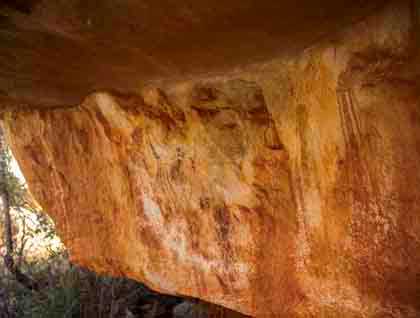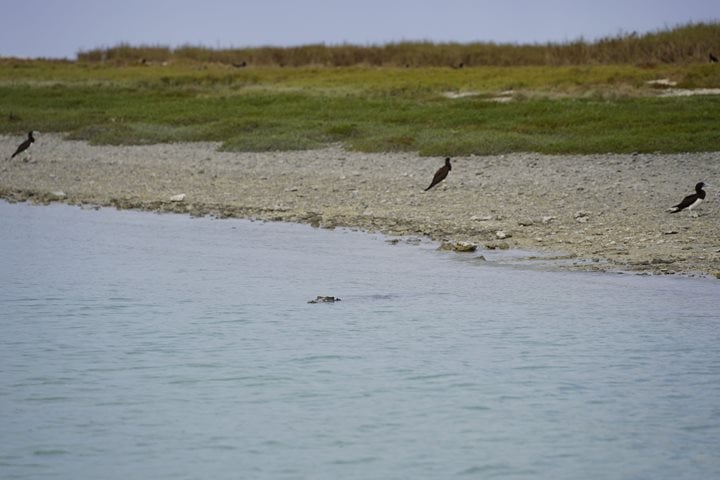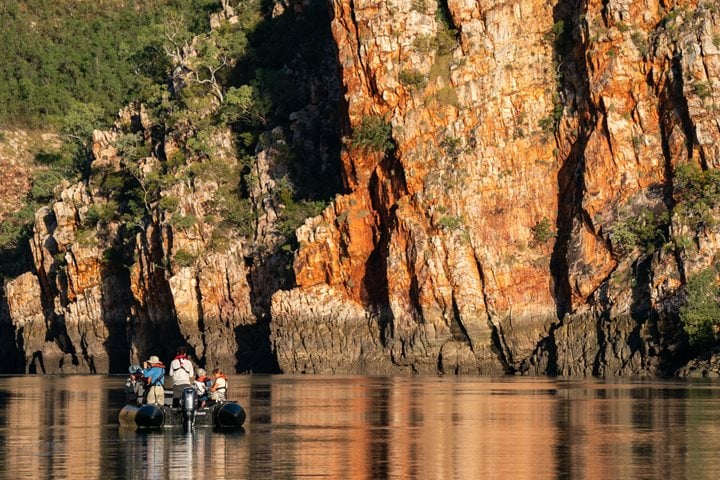Today we turned our attention to the human side of the Kimberley. Our species has occupied this beautiful region for many millennia, following the seasons and cycles of the plants and animals, becoming a part of this landscape and writing our own stories across the rocks and sand and sea.
These stories begin a very long time ago. Soon after we first left our birthplace in Africa we found our way along the coast of the Indian Ocean, down through Southeast Asia and across the shallow seas and land-bridges to Australia. By 50,000 years ago the ancestors of modern Aboriginal people were living in the Kimberley, hunting large game in the broad coastal plain that stretched out to the north in that time of lower sea levels. And they left us tantalizing traces of their lives, painted in bright hematite on the rocks that surrounded them.
Our morning explorations took us to Jar Island to visit several wonderful galleries of the style of rock art called Bradshaw or Gwion Gwion. We hiked a short distance inland on an easy trail and then threaded our way among sets of huge boulders, clambering over smaller rocks and roots to arrive at shady openings where ancient figures of men and animals surrounded us. Gwion Gwion art evolved considerably over the long period during which it was created and we saw many beautiful examples of several different styles, including the oldest “tassled” figures, the “clothes-peg” figures – named for the resemblance of the body forms to old wooden clothes pegs – and more recent illustrations of fish, crabs, echidnas and other animals that are perhaps best described as menus. Cristiana, Mark and Brent described their forms to us, pointing out many that were hidden in the shadows or under overhanging rocks and encouraging us to speculate on their significance. No one today fully understands Gwion Gwion art, but we felt a strong connection to the lives of the people who lived here and touched these very boulders so long ago, leaving beautiful and mysterious stories for us to contemplate.
Just a few hours later we landed at Vansittart Bay to visit the site of a much more recent adventure. The Zodiacs carried us to a beautiful curving beach of fine golden sand and we began our walk by climbing up a low crest of dunes behind the beach. From there we could look inland across a wide salt flat, surrounded by dark green mangrove forest and decorated with clusters of large sandstone boulders, deeply eroded by the wind and now appearing to float in the sediment of the salt pan.
We continued across the flat, stopping with Susan to soak up her advice on how to capture beautiful images of this strange place. Then, on the far side of the pan, we walked a short distance into the low, scrubby forest and came upon the nearly intact wreckage of a C-53, a military version of the famous DC-3. It had crashed here, with no loss of life, after becoming lost and running out of fuel on a run from Perth to Broome during the Second World War. The wreckage offered many more intriguing subjects for photography, working with the shadows of the trees on the fuselage, shooting in and out the windows and doors, or posing for portraits in the cockpit. Before we left some of us had a quick snack of the delicious lemony weaver ants that were nesting in the trees and then it was time to head back to our floating home for a more substantial dinner.
Wherever we go as travelers, we write our own stories, in our memories and in the lives we touch. Today our lives met those of other explorers, weaving new strands of unique experience into the long, long story of the Kimberley.







